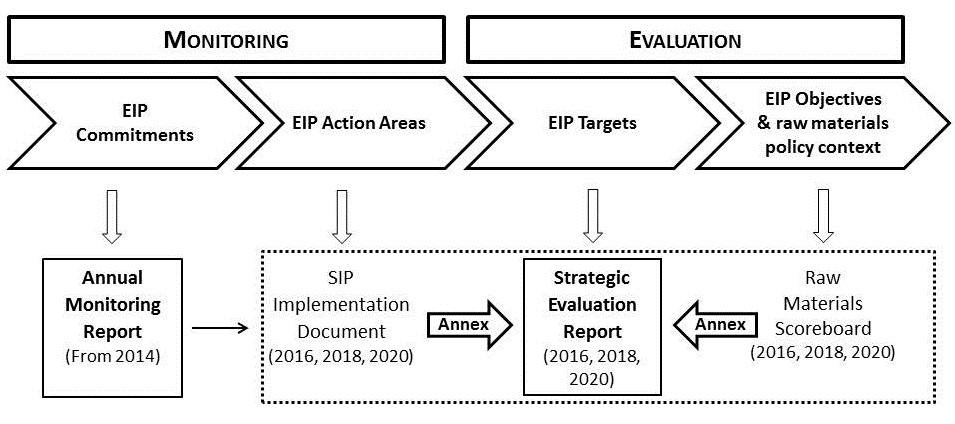EIP monitoring and evaluation scheme: a bottom-up approach
The European innovation partnership (EIP) on raw materials’ monitoring and evaluation scheme tracks progress on 4 different levels: the EIP’s raw materials commitments, action areas, targets and objectives.

Read the monitoring and evaluation scheme document
Monitoring & evaluation reports: an overview
Annual monitoring report
This report assesses the progress made by the EIP’s raw material commitments.
Commitments are joint undertakings by several partners, who commit to implement certain activities that will help to achieve the EIP's actions, targets and objectives. It is based on indicators that measure inputs (human resources, funding, etc.) and outputs related to the commitments.
The annual monitoring reports show that the EIP can count on 123 raw materials commitments, which include close to 980 unique partners from more than 50 different countries and have an indicative budget of close to €2 billion. They are found to be delivering tangible results such as innovative actions or pilots, strategic documents or knowledge sharing activities.
- Annual monitoring report 2017
- Annual monitoring report 2016
- Annual monitoring report 2015
- Annual monitoring report 2014
SIP implementation document
The SIP implementation document (SIPID) monitors the level of implementation of the EIP's strategic implementation plan (SIP). Its purpose is to provide an overview on the progress made towards the SIP's action area's objectives, including the use of the different instruments (Horizon 2020, Structural Funds, LIFE etc), the raw materials commitments and other initiatives undertaken by all relevant actors.
The SIP implementation document of 2016 presents a comprehensive overview of research and innovation projects and zooms in on the key achievements of the EIP since the adoption of the strategic implementation plan in 2013.
Strategic evaluation report
The EIP’s strategic implementation plan (SIP) sets out 7 targets for 2020. The strategic evaluation report assesses progress on the basis of the SIP implementation document. It also examines the broader picture relating to raw materials on the basis of the raw materials scoreboard.
The strategic evaluation report of 2016, which was presented to the high-level steering group on 14 July, also includes some strategic orientations for the future of the EIP.
Raw materials scoreboard
The raw materials scoreboard gives an overview of the challenges related to raw materials. It consists of 24 indicators grouped into 5 thematic clusters.
The scoreboard's purpose is to provide quantitative data on the EIP’s general objectives and on the raw materials policy context. It presents relevant and reliable information that can be used in policymaking in a variety of areas. The scoreboard will, for example, contribute to monitoring progress towards a circular economy, a crucial issue on which the European Commission recently adopted an ambitious action plan. The scoreboard will be published every 2 years.
